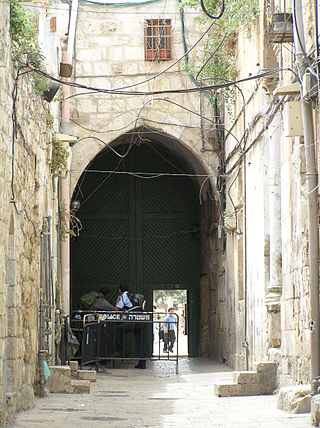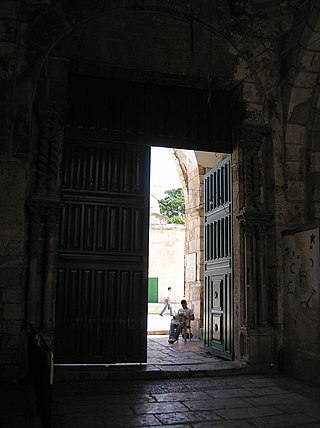
The Gates of Cairo were gates at portals in the city walls of medieval Islamic Cairo, within the present day city of Cairo, Egypt.

The Sublime Porte, also known as the Ottoman Porte or High Porte, was a synecdoche or metaphor used to refer collectively to the central government of the Ottoman Empire in Istanbul.

Bab Zuweila or Bab Zuwayla is one of three remaining gates in the city wall of the Old City of Cairo, the capital of Egypt. It was also known as Bawabbat al-Mitwali during the Ottoman period. It is considered one of the major landmarks of the city and is the last remaining southern gate from the walls of Fatimid-era Cairo in the 11th and 12th century.

Wagah, also spelled Wagha, is a village and union council located in the WahgaZone near Lahore City District, Pakistan. The town is famous for the Wagah border ceremony and also serves as a goods transit terminal and a railway station between Pakistan and India. Wahga is situated 600 metres (2,000 ft) west of the border and lies on the historic Grand Trunk Road between Lahore and Amritsar in India. The border is located 24 kilometres (15 mi) from Lahore and 32 kilometres (20 mi) from Amritsar. It is also 3 kilometres (1.9 mi) from the bordering village of Attari, India. The Wagah ceremony takes place every evening.

Bab al-Hadid meaning the Iron Gate of Victory, is one of the nine historical gates of the Ancient City of Aleppo, Syria. It is one of the well-preserved gates of old Aleppo.

Bāb Antakiya is a critical defense gate in Aleppo, and protects the city from the west. Bab Antakiya is located in the centre of the western wall of the old city of Aleppo, and its name was derived from Antioch, the capital of ancient Syria, as the gate was the main exit which was leading to the city of Antioch.

Bāb aṣ-Ṣaghīr, also called Goristan-e-Ghariban, may refer to one of the seven gates in the Old City of Damascus, and street in the modern city of Damascus, Syria. It has qubūr on either side of the road, and is located in the Dimashq Neighborhood, southwest of the Umayyad Mosque.
The term bāb was used in early Shia Islam for senior disciples, and authorised deputies, of the current Imam. Less commonly, the term is also applied to the Imams themselves, as well as to Muhammad and other prophets in Islam.

Bab al-Faraj, meaning the Gate of Deliverance or Bab al-Faradis was one of the 9 main gates of the ancient city walls of Aleppo, Syria. It was located at the northern side of the ancient city. The gate was ruined in 1904. Some remains are still found at the north-eastern part of the gate.

Bab al-Faradis or Bab al-Amara is one of the seven ancient city-gates of Damascus, Syria. The other name, Bab Al-Amara, refers to a name of a district in the old city where people in the 14th century would meet. During the Roman era, the gate was dedicated to Mercury.

Bab al-Jabiya is one of the seven ancient city-gates of Damascus, Syria. During the Roman era, the gate was dedicated to Mars. Bab al-Jabiya was the main entrance on the city's west side. The gate opens on Medhat Pasha Souq, which is the modern western half of the Street Called Straight, the Roman east-west artery (decumanus), which still connects it to Bab Sharqi. The gate's modern name dates to the Umayyad period and comes from the name of Jabiyah in the Golan Heights, then the capital city of the Ghassanids, allies of the Roman Empire.

Bab al-Salam is one of the seven ancient city-gates of Damascus, Syria. During the Roman era, it was also known as "Gate of the Moon".

Bab Sharqi, also known as the Gate of the Sun, is one of the seven ancient city gates of Damascus, Syria. Its modern name comes from its location in the eastern side of the city. The gate also gives its name to the Christian quarter surrounding it. The grand facade of the gate was reconstructed in the 1960s.

Bab al-Futuh is one of three remaining gates in the city wall of the old city of Cairo, Egypt. It is located at the northern end of al-Mu'izz Street. The other two remaining gates are Bab al-Nasr in the north and Bab Zuwayla in the south. The gate was built during the Fatimid period, originally in the 10th century, then rebuilt in its current form in the late 11th century.

Bab al-Nasr, is one of three remaining gates in the historic city wall of Cairo, the capital of Egypt. The gate's construction is dated to 1087 and was ordered by Badr al-Jamali, a Fatimid vizier. It is located at the northern end of Shari'a al-Gamaliya in the old city of Cairo and slightly east of another contemporary gate, Bab al-Futuh.

Bāb Ḥuṭṭa is a neighborhood in the Muslim Quarter of the Old City of Jerusalem to the north of Al-Aqsa Compound. The name literally means "Forgiveness Gate", referring to the Remission Gate of the Haram compound, connected by Bāb Ḥuṭṭa Street.
Shagai Fort is a fort located 13 kilometres from Jamrud in Khyber District, Khyber Pakhtunkhwa, Pakistan. It was built in 1927 by the British forces to oversee the Khyber Pass. The estimated terrain elevation above sea level is 847 metres. It is manned by Pakistani military and paramilitary troops serving as headquarters for the Khyber Rifles — the traditional guardians of the Khyber Pass.

Bab al-Wazir - the Minister's Gate - was one of the gates in the walls of the Old City of Cairo. It was finished in 1341 by a vizier of Sultan An-Nasir Muhammad and demolished in 2013.

The Inspector's Gate is one of the gates of the al-Aqsa Compound. It is the second-northernmost gates in the compound's west wall, after the Bani Ghanim Gate. It is north of the Iron Gate.

The Chain Gate is one of the gates to the Al-Aqsa Mosque compound on the Temple Mount in the Old City of Jerusalem. It was previously known as David's Gate. As it was named in the early Islamic period Bāb Daud which means David's Gate. It was also known as Bāb al-Maḥkama, named after the nearby Tankiziyya.


















